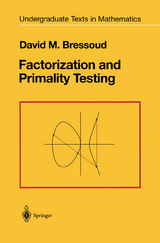Factorization and Primality Testing
Springer-Verlag New York Inc.
978-0-387-97040-0 (ISBN)
"About binomial theorems I'm teeming with a lot of news, With many cheerful facts about the square on the hypotenuse. " - William S. Gilbert (The Pirates of Penzance, Act I) The question of divisibility is arguably the oldest problem in mathematics. Ancient peoples observed the cycles of nature: the day, the lunar month, and the year, and assumed that each divided evenly into the next. Civilizations as separate as the Egyptians of ten thousand years ago and the Central American Mayans adopted a month of thirty days and a year of twelve months. Even when the inaccuracy of a 360-day year became apparent, they preferred to retain it and add five intercalary days. The number 360 retains its psychological appeal today because it is divisible by many small integers. The technical term for such a number reflects this appeal. It is called a "smooth" number. At the other extreme are those integers with no smaller divisors other than 1, integers which might be called the indivisibles. The mystic qualities of numbers such as 7 and 13 derive in no small part from the fact that they are indivisibles. The ancient Greeks realized that every integer could be written uniquely as a product of indivisibles larger than 1, what we appropriately call prime numbers. To know the decomposition of an integer into a product of primes is to have a complete description of all of its divisors.
1 Unique Factorization and the Euclidean Algorithm.- 1.1 A theorem of Euclid and some of its consequences.- 1.2 The Fundamental Theorem of Arithmetic.- 1.3 The Euclidean Algorithm.- 1.4 The Euclidean Algorithm in practice.- 1.5 Continued fractions, a first glance.- 1.6 Exercises.- 2 Primes and Perfect Numbers.- 2.1 The Number of Primes.- 2.2 The Sieve of Eratosthenes.- 2.3 Trial Division.- 2.4 Perfect Numbers.- 2.5 Mersenne Primes.- 2.6 Exercises.- 3 Fermat, Euler, and Pseudoprimes.- 3.1 Fermat’s Observation.- 3.2 Pseudoprimes.- 3.3 Fast Exponentiation.- 3.4 A Theorem of Euler.- 3.5 Proof of Fermat’s Observation.- 3.6 Implications for Perfect Numbers.- 3.7 Exercises.- 4 The RSA Public Key Crypto-System.- 4.1 The Basic Idea.- 4.2 An Example.- 4.3 The Chinese Remainder Theorem.- 4.4 What if the Moduli are not Relatively Prime?.- 4.5 Properties of Euler’s ø Function.- Exercises.- 5 Factorization Techniques from Fermat to Today.- 5.1 Fermat’s Algorithm.- 5.2 Kraitchik’s Improvement.- 5.3 Pollard Rho.- 5.4 Pollard p — 1.- 5.5 Some Musings.- 5.6 Exercises.- 6 Strong Pseudoprimes and Quadratic Residues.- 6.1 The Strong Pseudoprime Test.- 6.2 Refining Fermat’s Observation.- 6.3 No “Strong” Carmichael Numbers.- 6.4 Exercises.- 7 Quadratic Reciprocity.- 7.1 The Legendre Symbol.- 7.2 The Legendre symbol for small bases.- 7.3 Quadratic Reciprocity.- 7.4 The Jacobi Symbol.- 7.5 Computing the Legendre Symbol.- 7.6 Exercises.- 8 The Quadratic Sieve.- 8.1 Dixon’s Algorithm.- 8.2 Pomerance’s Improvement.- 8.3 Solving Quadratic Congruences.- 8.4 Sieving.- 8.5 Gaussian Elimination.- 8.6 Large Primes and Multiple Polynomials.- 8.7 Exercises.- 9 Primitive Roots and a Test for Primality.- 9.1 Orders and Primitive Roots.- 9.2 Properties of Primitive Roots.- 9.3Primitive Roots for Prime Moduli.- 9.4 A Test for Primality.- 9.5 More on Primality Testing.- 9.6 The Rest of Gauss’ Theorem.- 9.7 Exercises.- 10 Continued Fractions.- 10.1 Approximating the Square Root of 2.- 10.2 The Bháscara-Brouncker Algorithm.- 10.3 The Bháscara-Brouncker Algorithm Explained.- 10.4 Solutions Really Exist.- 10.5 Exercises.- 11 Continued Fractions Continued, Applications.- 11.1 CFRAC.- 11.2 Some Observations on the Bháscara-Brouncker Algorithm.- 11.3 Proofs of the Observations.- 11.4 Primality Testing with Continued Fractions.- 11.5 The Lucas-Lehmer Algorithm Explained.- 11.6 Exercises.- 12 Lucas Sequences.- 12.1 Basic Definitions.- 12.2 Divisibility Properties.- 12.3 Lucas’ Primality Test.- 12.4 Computing the V’s.- 12.5 Exercises.- 13 Groups and Elliptic Curves.- 13.1 Groups.- 13.2 A General Approach to Primality Tests.- 13.3 A General Approach to Factorization.- 13.4 Elliptic Curves.- 13.5 Elliptic Curves Modulo p.- 13.6 Exercises.- 14 Applications of Elliptic Curves.- 14.1 Computation on Elliptic Curves.- 14.2 Factorization with Elliptic Curves.- 14.3 Primality Testing.- 14.4 Quadratic Forms.- 14.5 The Power Residue Symbol.- 14.6 Exercises.- The Primes Below 5000.
| Erscheint lt. Verlag | 2.10.1989 |
|---|---|
| Reihe/Serie | Undergraduate Texts in Mathematics |
| Zusatzinfo | XIV, 240 p. |
| Verlagsort | New York, NY |
| Sprache | englisch |
| Maße | 156 x 234 mm |
| Themenwelt | Mathematik / Informatik ► Mathematik ► Algebra |
| Mathematik / Informatik ► Mathematik ► Arithmetik / Zahlentheorie | |
| Mathematik / Informatik ► Mathematik ► Wahrscheinlichkeit / Kombinatorik | |
| ISBN-10 | 0-387-97040-1 / 0387970401 |
| ISBN-13 | 978-0-387-97040-0 / 9780387970400 |
| Zustand | Neuware |
| Haben Sie eine Frage zum Produkt? |
aus dem Bereich




